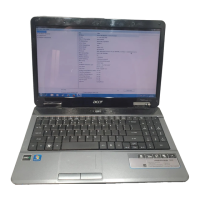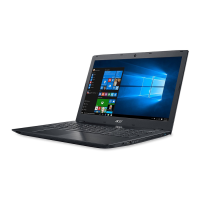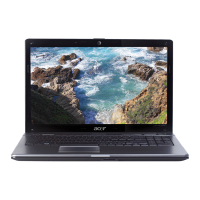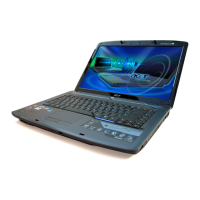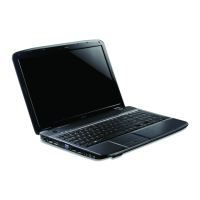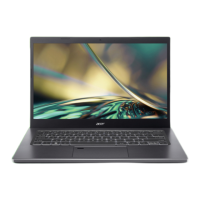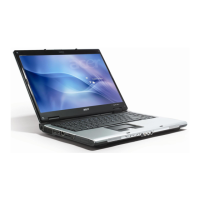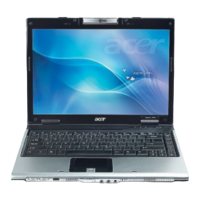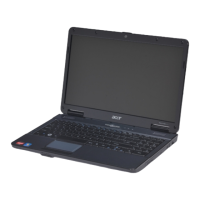Do you have a question about the Acer Aspire 5536 and is the answer not in the manual?
Summary of computer features including platform and system memory.
Details on display resolution, aspect ratio, and graphics controllers.
Information on hard disk drives and optical drive options.
Describes the keyboard and touchpad features.
Details on audio system features like speakers and surround sound.
Information on webcam, VoIP, Wi-Fi, and WWAN capabilities.
Lists and describes the various input/output ports on the computer.
Specifies operating and storage temperature and humidity ranges.
Provides the physical dimensions and weight of the notebook.
Identifies components visible on the front of the laptop.
Identifies components visible on the closed front view of the laptop.
Identifies and describes ports on the left side of the laptop.
Identifies ports on the right side of the laptop.
Identifies components on the bottom of the laptop.
Describes the special function keys above the keyboard.
Explains how to use the touchpad and its buttons.
Explains Caps Lock, Num Lock, and the numeric keypad functions.
Details functions of Windows-specific keys and shortcuts.
Explains the Acer GridVista utility for managing multiple displays.
Details CPU types, core logic, package, and voltage for different models.
Lists BIOS vendor and version.
Details memory controller, size, DIMM sockets, and max memory.
Details Bluetooth chipset, data throughput, protocol, and interface.
Details wireless module chipset, data throughput, protocol, and interface.
Lists HDD vendor, model, capacity, performance specs, and power requirements.
Lists optical drive vendor, performance, applicable disc formats, and loading mechanism.
Details Blu-ray drive specifications including transfer rate and applicable disc formats.
Describes audio controller, onboard status, mono/stereo, and resolution.
Details video memory chipset and size.
Details USB chipset, compliancy level, port count, and location.
Lists major chips on the system board and their controllers.
Details keyboard controller, key count, and simultaneous input.
Details battery vendor, type, pack capacity, cell count, and configuration.
Provides specifications for the 15.6-inch LCD panel.
Specifies operating and storage temperature ranges.
Details AC adapter input and output specifications.
Explains ACPI modes and power management states.
Introduces the BIOS setup utility for hardware configuration.
Provides instructions on navigating the BIOS setup menus and options.
Displays system hardware information summary.
Allows setting system time, date, and boot options.
Contains parameters for safeguarding computer access.
Step-by-step guide to setting user or supervisor passwords.
Instructions for removing existing passwords.
Steps to change an existing password.
Allows selecting the order of boot devices.
Confirms or discards changes made in BIOS setup.
Explains how to update the system BIOS flash ROM.
Instructions for removing an HDD password.
Lists necessary tools for disassembling the notebook.
Provides pre-disassembly instructions and general guidance.
Flowchart illustrating the external component disassembly sequence.
Step-by-step instructions for removing the battery pack.
Procedure for removing the SD dummy card.
Steps to remove the DIMM (memory) module.
Instructions for removing the notebook's back cover.
Steps to remove the hard disk drive module.
Procedure for removing the wireless LAN modules.
Steps to remove the optical drive module.
Flowchart detailing the main unit disassembly sequence.
Instructions for removing the middle cover.
Steps to remove the laptop keyboard.
Procedure for removing the LCD module assembly.
Steps to separate the upper and lower case halves of the notebook.
Instructions for removing fingerprint and touchpad boards.
Procedure for removing the left speaker module.
Steps to remove the USB board module.
Instructions for removing the modem module.
Procedure for removing the Bluetooth module.
Steps to remove the right speaker module.
Instructions for removing the main system board.
Procedure for removing the heatsink module.
Steps to remove the CPU from the socket.
Flowchart for disassembling the LCD module.
Instructions for removing the LCD bezel.
Steps to remove the LCD panel and its brackets.
Procedure for removing the LCD panel brackets.
Instructions for detaching the FPC cable from the LCD panel.
Procedure for removing the wireless antennas.
Steps to remove the web camera module.
Outlines procedures for checking system components.
Procedure for diagnosing memory errors.
Steps to verify power supply and battery operations.
Procedure for checking battery pack status and charge operation.
Troubleshooting steps for touchpad issues.
Index of POST error messages and their causes.
Lists error codes and their corresponding error messages.
Lists BIOS beep codes and their POST routine descriptions.
Maps symptoms to potential FRU replacements.
Addresses issues that occur sporadically and are hard to reproduce.
Procedures for isolating failures when diagnostics are inconclusive.
Identifies connectors on the top view of the main board.
Identifies connectors on the bottom view of the main board.
Procedures for clearing BIOS passwords and recovering BIOS.
Exploded diagram showing FRU components.
Lists adapter part numbers and descriptions.
Lists battery part numbers and descriptions.
Lists various board part numbers and descriptions.
Lists cable part numbers and descriptions.
Lists camera part numbers and descriptions.
Lists case, cover, and bracket assembly part numbers.
Lists CPU and processor part numbers.
Lists hard disk drive part numbers and specifications.
Lists heatsink part numbers.
Lists keyboard part numbers and regional variations.
Model definitions and configurations for the Aspire 5738 series.
Model definitions and configurations for the Aspire 5536 series.
Lists components tested for compatibility with Windows Vista.
Lists PCMCIA card types tested for compatibility.
| Processor cache | 1 MB |
|---|---|
| Processor model | RM-72 |
| Processor frequency | 2.1 GHz |
| Processor cache type | L2 |
| Processor front side bus | 800 MHz |
| Motherboard chipset | AMD M780G |
| HDD speed | 5400 RPM |
| HDD interface | SATA |
| Optical drive type | DVD Super Multi DL |
| Card reader integrated | Yes |
| Total storage capacity | 320 GB |
| Compatible memory cards | Memory Stick (MS), MMC, MS PRO, SD, xD |
| Display diagonal | 15.6 \ |
| Display brightness | 220 cd/m² |
| Display resolution | 1366 x 768 pixels |
| Native aspect ratio | 16:9 |
| Display response rise/fall | 8 ms |
| Memory slots | 2x SO-DIMM |
| Internal memory | 3 GB |
| Memory clock speed | 667 MHz |
| Internal memory type | DDR2-SDRAM |
| Maximum internal memory | 8 GB |
| Memory layout (slots x size) | 1 x 1 + 1 x 2 GB |
| Discrete graphics card model | AMD Radeon HD 3200 |
| Maximum graphics card memory | 2.048 GB |
| Type | PC |
| Modem speed | 56 Kbit/s |
| TV tuner integrated | No |
| Wireless technology | Wi-Fi |
| Graphics card family | AMD |
| Compatible operating systems | Linux Windows Vista |
| Compliance industry standards | IEEE 802.3, IEEE 802.3u, IEEE 802.3ab |
| Internal video mode, resolution | 2048 x 1536 pixels |
| Cabling technology | 10/100/1000Base-T(X) |
| Networking features | Gigabit Ethernet |
| Operating system installed | Windows Vista Home Premium |
| Battery capacity | 4400 mAh |
| Battery life (max) | 3 h |
| Number of battery cells | 6 |
| AC adapter power | 65 W |
| Charging port type | DC-in jack |
| Serial ports quantity | 0 |
| USB 2.0 ports quantity | 4 |
| Cable lock slot type | Kensington |
| Password protection type | BIOS |
| Product color | Black |
| Front camera resolution (numeric) | 0.3 MP |
| Pointing device | Touchpad |
| Depth | 250 mm |
|---|---|
| Width | 383 mm |
| Weight | 2800 g |
| Height (rear) | 37 mm |
| Height (front) | 26 mm |
